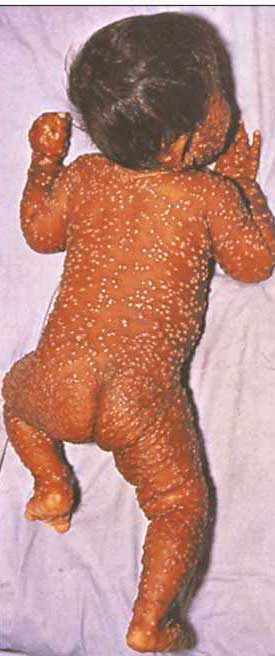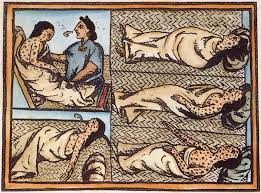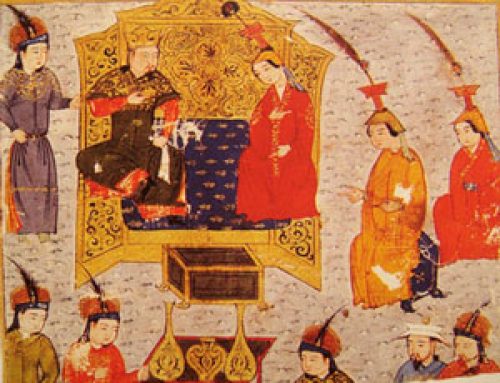
A baby with smallpox (from the CDC) – History of smallpox
What was smallpox?
Smallpox was a very serious disease caused by a virus. Many people died of it. Smallpox caused little bumps on your skin, like chickenpox but much more serious. About two to five of every ten people who got smallpox died of it. There was (and is still) no treatment that worked.
Tuberculosis
Malaria
Measles
History of diseases
Where did smallpox come from?
Smallpox is probably originally a Central Asian disease. The first time we know of anybody having smallpox (at least we think it was smallpox) is in the Parthian empire about 150 AD. It may have been a smallpox epidemic that weakened the Parthian army so that the Roman army was able to push it back (or it may have been measles).
Who were the Parthians?
Central Asian medicine
Roman medicine
The Romans under Marcus Aurelius
Smallpox spreads all over Eurasia
But when the Roman soldiers returned home from that war, about 160 AD, they brought the smallpox with them. Many soldiers, and many other people in the Roman Empire, died of smallpox over the next hundred years. Smallpox spread the other direction, east to China, about the same time, possibly weakening and ending the Han Dynasty and leading to civil war.
Han Dynasty China
Guptan India
Chinese medicine
Indian medicine and doctors
The next smallpox outbreak we know about was in India, around 400 AD. Doctors in India described it as like grains of rice all over your skin, with burning pain. They blamed it on a new goddess, Sitala.
Why did smallpox epidemics stop?
There was a serious outbreak of smallpox in Europe about 581 AD. After that, there were smaller outbreaks in Europe here and there, but it’s just like chickenpox, once you get it once you usually can’t get it again, and so once a lot of people were immune future outbreaks were not as serious.
Inoculation and smallpox
About 900 AD, the Islamic doctor Al Razi was the first to show that measles and smallpox were two different diseases. By about 1000 AD, doctors in India and China were beginning to figure out how to prevent smallpox, though they still couldn’t help you once you had caught it.
Who was al Razi?
What is inoculation?
Medieval Islamic medicine
In India, doctors rubbed pus from a sore on a person with smallpox into a small cut on your arm. In China, doctors blew powdered smallpox scabs up your nose through a little tube. This worked like a vaccination. It wasn’t as good as a vaccination, because some people didn’t become immune, and some other people caught real smallpox from it. Many people were afraid to get inoculated. But it worked a lot of the time, and it was much better than nothing. These ways of vaccinating people became common in China and India and in the Islamic world, and also in East Africa, but nobody in Europe even knew about it.
Smallpox spreads to the Americas

Aztec doctor treating people with smallpox (1500s AD, Codex Mendoza) – History of smallpox
In the 1500s AD, when people from Europe first began to go to Central America and South America, they brought an enslaved man from Africa with them. It turned out he had smallpox. Some of the people who lived in the Americas caught it.
Who were the Aztec?
Native American medicine
None of these people were immune, and within a few years about 60-90 percent of the people died. (That’s six to nine out of every ten people!) Soon people in North America caught smallpox too. Most of them also died. Most of the people in North and South America died of either smallpox or measles – that’s part of why the Europeans were able to conquer them.

Child with smallpox (Bangladesh 1973) – History of smallpox
Inoculation in Europe and the Americas
Finally in the 1700s people in Europe and in North America began to hear about the Indian inoculation process, and they started to use it. The French philosopher Voltaire helped to convince people to do it. In Boston, an African man named Onesimus who worked for Cotton Mather as a slave told people that he had been inoculated in Africa, before he left, and explained how to do it.
African-American slavery
Who was Voltaire?
Louis XV of France

Louis XV, King of France
Even so, the king of France, Louis XV, died of smallpox in 1774. Gradually in the late 1700s and 1800s doctors developed methods of vaccinating using shots instead of inoculating by blowing scabs up your nose. Vaccination worked much better. European doctors had a lot of time and money for research, because they forced lots of enslaved people and colonized people to do work for them. So the doctors were able to make new discoveries.
The end of smallpox
More and more people were vaccinated, all over the world. At first, it was mainly Europeans and rich Americans. But pretty soon doctors were vaccinating people in other countries too. In Iran, for example, most people were vaccinated about 1850. Very slowly, whole countries, then whole continents started to be free of smallpox again. The last case of smallpox in the world was in 1977, in Somalia (East Africa).
Did you find out what you wanted to know about the history of smallpox? Let us know in the comments!
Learn by doing: get yourself vaccinated against diseases
More about viruses
And more about vaccination
Indian invention of inoculation
Bibliography and further reading about smallpox:




